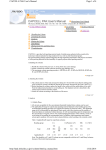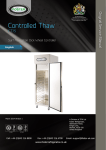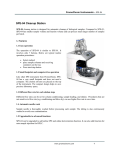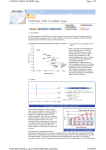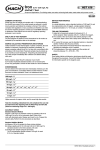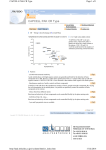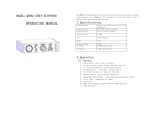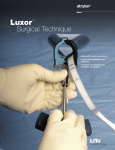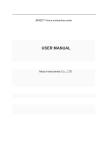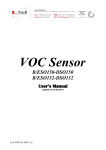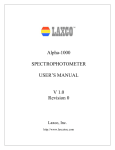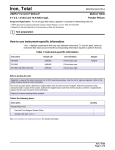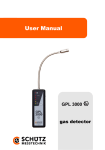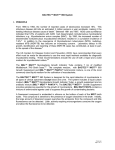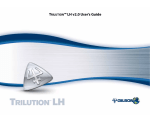Download Page 1 of 1 Ceramospher (Chiral) 17.02.2014 http://hplc.shiseido.co
Transcript
Ceramospher (Chiral) Page 1 of 1 List of Sales Representatives Contact Shiseido HPLC Columns Catalog List Ceramospher is coined from "ceramic" and "sphere." This is a completely new type of column for optical separation where the optically active metal complex Δ-Ru(phen)32+(phen=1,10-phenanthroline) is adsorbed to porous spherical ceramics by cation exchange. HPLC Instruments The clay mineral used for the chromatographic support has a multilayer structure. Analyte molecules are supposed to enter narrow gaps between the layers, and to fit into environments where three-dimensional interactions for chiral recognition take place. When trying many chiral compounds, probability of successful optical separation is much higher than those of conventional chiral columns. Large-Diameter Columns and Preparative Devices Purification Services Adobe Acrobat Reader is required to view PDF files. Click here to download Adobe Acrobat Reader. Technical Materials Difference between RU-1 and RU-2 RU-2 packing material is created from RU-1 by further special hydrophobic treatment. Consequently, Ceramospher (Chiral) RU-2 allows the use of aqueous (reversed phase) mobile phases. Features · Excellent separation hit rate → Optimum choice, particularly for the optical separation of neutral and acidic compounds → No need to optimize conditions → Analytical conditions can be easily set by using a flowchart · High loadability → 5 to 10 times higher than that of conventional columns for optical separation · Excellent durability · Excellent pressure resistance (20 MPa) · Stable in a wide temperature range RU-1 RU-2 20 to 60°C (methanol type) 15 to 60°C (water/methanol type) · Also available outside Japan Property values Type Particle size (µm) Specific surface area (m2/g) Acceptable pH Pore size (nm) RU-1 5 300 3~6.5 4 RU-2 5 300 3~6.5 4 http://hplc.shiseido.co.jp/e/column/html/ce_index.htm 17.02.2014 Ceramospher (Chiral) Page 1 of 4 List of Sales Representatives Contact Shiseido Technical Materials Catalog List Ceramospher (Chiral) User's Manual HPLC Columns HPLC Instruments Large-Diameter Columns and Preparative Devices Purification Services 1. Handling the Column 2. Attaching the Column 3. Analysis 4. Storing the Column 5. End Fittings 6. Replacement Parts and Repair Items 7. Troubleshooting Ceramospher Chiral RU-1 and RU-2 are unique columns for chiral separation that are based on spherical ceramics. Adobe Acrobat Reader is required to view PDF files. Click here to download Adobe Acrobat Reader. 1. Handling the Column 1. Handle the column with great care. A strong shock may cause damage. 2. Attach or detach the column when the pressure gage indicates zero. 2. Attaching the Column 1. The column joint is of the male nut type for tubing of 1/16 inch OD. Check that the piping joints of the system fit correctly and that the ferrule tips are deeply inserted into the joints. (See Fig. 1.) 2. Before attaching the column, replace the liquid in the system with the mobile phase to be used. (Refer to the section on mobile phases.) 3. Attach the column according to the direction of the arrow. 3. Analysis 3-1. Mobile Phase 1. RU-1 1. In addition to methanol, non-aqueous solvents such as ethanol, isopropanol, acetonitrile, chloroform, and n-hexane are acceptable. It is advised to try methanol at first, and to use other solvents only when methanol does not provide a good separation. 2. A mobile phase prepared by adding isopropylamine, diethylamine, triethylamine, or acetic acid of up to 1vol% to methanol is also acceptable. 3. After degassing completely, filtrate the mobile phase using a membrane filter 0.45 µí or smaller to remove dust. A 2-µí filter is used at the column inlet. To prevent foreign matter from clogging the column inlet filter, we recommend using a line filter. 4. Methanol is sealed in the column. 5. When using a mobile phase from the same resevoir over a long period, it is necessary to take chemical or physical measures to remove moisture out of the liquid. 6. To prevent column deterioration, avoid the following: . Injection of a mobile phase or a sample solution containing water . Frequent change of the mobile phase composition or direct change to a mobile phase of low compatibility . Rapid change in column inlet pressure . High column pressure due to the use of a high-viscosity mobile phase 7. The maximum operating pressure of this column is 20 MPa. To ensure that this pressure is not exceeded, set the flow rate as follows. Set the flow rate and pressure using the following values as the standards (reference values). (50°C, methanol, and MPa) 0.5mL/min http://hplc.shiseido.co.jp/e/column/html/ce_manual.htm 1.0mL/min 1.5mL/mina 2.0mL/min 13.02.2014 Ceramospher (Chiral) Page 2 of 4 4.6mmx150mm 3 6 9 9 4.6mmx250mm 5 10 15 25 (50°C, methanol, and MPa) 2.RU-2 1. Preparing a Mobile Phase Aqueous Type (Water Content: 1070vol%) Non-Aqueous Type Neutral Compound MeOH or acetonitrile Potassium dihydrogenphosphate of 0.5 to 5 mmol/L (No precipitation allowed) Basic Compound 0.1-1vol% diethylamine / MeOH or acetonitrile 0.01-0.1vol% diethylamine/MeOH or acetonitrile Acetic acid of 0.01-0.11vol% / MeOH or acetonitrile Acidic Compound 0.1-1vol% acetic acid / MeOH or acetonitrile Amphoteric Compound Derivatize chemically, and treat as the neutral (above) potassium dihydrogenphosphate of 0.5 to 5 mmol/L (No precipitation allowed) *When an acetic acid solution is used, the waste liquid is slightly colored. However, this will not affect column performance. Dispose of the waste liquid as heavy metal-containing liquid. 2. Methanol is sealed in the column at the time of shipment. 3. To prevent column deterioration, avoid the following: . Frequent change of the mobile phase composition or direct change to a mobile phase of low compatibility . Rapid change in column inlet pressure . High column pressure due to the use of a high-viscosity mobile phase 4. The maximum operating pressure of this column is 20 MPa. To ensure that this pressure is not exceeded, set the flow rate as follows: Methanol 1.0 mL/min Water/Methanol 0.5mL/min Acetonitrile 1.0mL/min Water/Acetonitrile 0.5mL/min 5. Since potassium dihydrogenphosphate does not easily dissolve in a solution of water/methanol or water/acetonitrile, prepare the solution by the following procedure: 1. Dissolve potassium dihydrogenphosphate completely in water. 2. Add methanol or acetonitrile to the solution while stirring. 3. After degassing, check that potassium dihydrogenphosphate is not precipitated. 3-2. Preparing a Sample Solution 1. Dissolve the sample in a solvent of the same composition as the mobile phase wherever possible. 2. Using a solvent with strong dissolving power may lower separation efficiency or cause the sample to precipitate at the column head. 3. If there is insoluble matter remaining in the sample solution, filtrate the solution using a filter 0.45 µm or smaller. 3-3. Temperature 1.RU-1 Ceramospher RU-1 is extremely temperature stable. Although the operating temperature differs depending on the viscosity and boiling point of the mobile phase, Ceramospher RU-1 can be used in the range from 20 to 50°C if the mobile phase is of the methanol type. 2.RU-2 Ceramospher RU-2 is extremely temperature stable. Although the operating temperature differs depending on the viscosity and boiling point of the mobile phase, Ceramospher RU-2 can be used in the range from 15 to 60°C if the mobile phase is of the water or methanol type. 4. Storing the Column http://hplc.shiseido.co.jp/e/column/html/ce_manual.htm 13.02.2014 Ceramospher (Chiral) Page 3 of 4 1. Seal the column with the accessory plug and store it in a cold place where there is little temperature fluctuation. 2. After using an aqueous mobile phase or the above mobile phase with acetic acid or amines added, rinse the column with methanol and store it after sealing with methanol. 5. End Fittings 1. An analytical column of up to 6-mm ID uses a filter-embedded end fitting as shown in Fig.. The filter cannot be changed alone. If the filter is clogged or the column pressure is high, replace the end fitting. See Table 4 for the replacement parts and repair items. 2. See Fig. 1 for the column connection. If the tubing is inappropriate, especially if a tube for a different type of column is used, the length after the ferrule tip (V in Fig. 1) is often different from the end fitting length L, and a problem may occur. If L is greater than V, dead volume may be generated and cause peak broadening or tailing or deterioration of separation performance. If L is smaller than V, liquid may leak because of inadequate ferrule adhesion. Therefore, we recommend replacing the ferrule together with the column. *If the column is replaced frequently, the male nut may crush the ferrule and liquid may leak. Since tightening the nut too much may cause its head to come off, replace the ferrule at an early stage. Fig. 1 Column connection 6. Replacement Parts and Repair Items Table 4 Replacement parts and repair items Part No. Part Name Description EF2052 End fitting (4.6 mm) 2 pieces EF2160 Piping kit(2pcs) Male nuts (1/6) and ferrules (1/16) 2pieces each EF2161 Ferrule (1/16) Ferrules (1/16)10pieces 7. Troubleshooting Problems in high performance liquid chromatography are attributable to various causes that cannot all be enumerated. The table below describes some comparatively common problems related to the column. Symptom Cause Measures 1. Column pressure rise. Blocking with foreign matter 1. Dust or insoluble matter in the mobile phase or sample solution. 2. Dirt in the tubing. 3. Plunger seal fragment. 4. Precipitation of sample components. • Sonicate the filter or replace it. • Filtrate the mobile phase and sample solution in advance using a membrane filter. • Attach a line filter. • Clean the tubing and replace the plunger seal. • Prepare a sample solution with the mobile phase. 2. Peak splitting, 1. Dead volume due to • Reconnect the tubing. http://hplc.shiseido.co.jp/e/column/html/ce_manual.htm 13.02.2014 Ceramospher (Chiral) Page 4 of 4 tailing, and broadening. 3. Retention time too long or unstable. inappropriate connections. 2. Column deterioration. * Not repairable in the case of column deterioration or damage to interior channel. • Check the column performance using standard samples. 1. Liquid leak (Indicated on the pressure gage of the pump). 2. Mixing of air. • Check the pump and tubing for any leaks. See 2-3. • Secure adequate equilibration time. • Purge air. (RU-2) • Use a degasser. (RU-2) Ceramospher Chiral RU-1/RU-2 is shipped after a strict performance check. However, if you should find any defect, please contact your dealer or Shiseido for replacement. Note that Shiseido does not warrant the product against column life or deterioration caused by the failure to follow the above handling instructions. Ten or more days after reception by the customer, Shiseido will assume that the product was delivered in good condition, and will not accept a later replacement request. http://hplc.shiseido.co.jp/e/column/html/ce_manual.htm 13.02.2014





